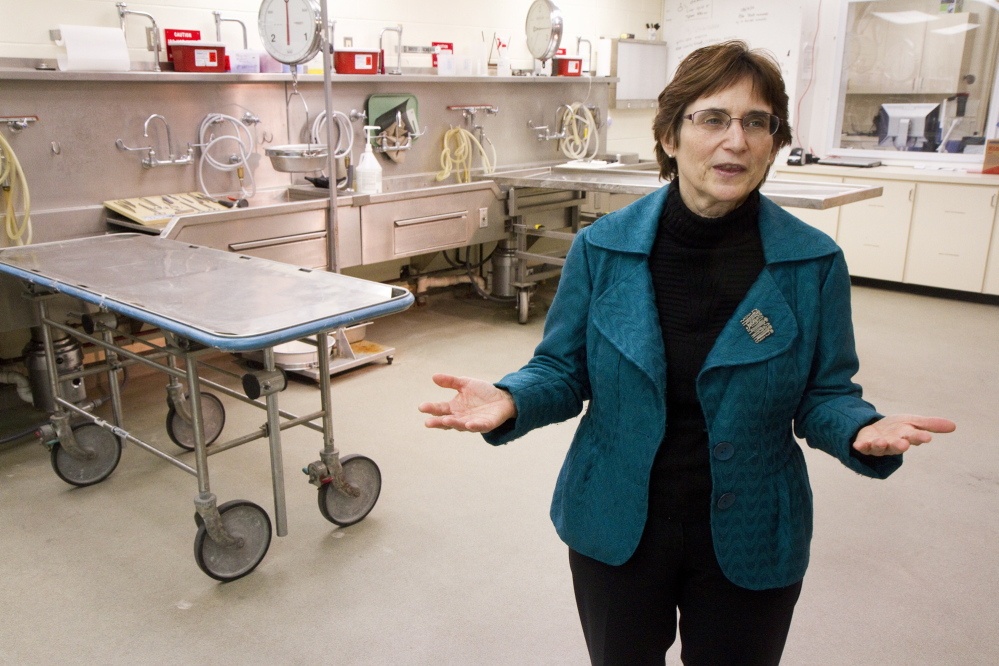AUGUSTA — On the last day of his life, a Friday in February, Ben LaMontagne was an apparently healthy high school senior recovering from the removal of his wisdom teeth.
Hours later, after waking in the early morning hours, he died in his mother’s arms.
The cause of LaMontagne’s death is still unknown. In such cases, that determination falls to the Office of Chief Medical Examiner.
But now, three months after an autopsy was done and tissue samples were collected, the results of the investigation are still pending, caused by a backlog of cases at the medical examiner’s office, where high staff turnover, limited financial resources and a growing caseload have slowed the release of results in even relatively simple deaths. The announcement Friday that the chief medical examiner had retired also highlighted the difficulty the office has in finding qualified medical staff to handle the workload.
Meanwhile, LaMontagne’s friends and family are still waiting for answers to explain the death of a talented young man.
“I would be curious, from a medical standpoint, did he have an underlying condition that nobody caught?” said Julia Frothingham, LaMontagne’s music teacher, who is also a nurse. “People get wisdom teeth out all the time and never have this kind of complication.”
While national standards by the National Association of Medical Examiners recommend a maximum of 60 days to determine the cause of death in uncomplicated cases and 90 days for homicides, Maine’s medical examiner’s office falls far short, regularly estimating a six-month average for results, up from an average three-month wait in 2011.
Maine is not alone in failing to meet the standard. Currently, only 79 medical examiner offices, out of roughly 2,300 jurisdictions in the nation, are accredited by the National Association of Medical Examiners. Part of the reason so few are accredited is the time it takes cash-strapped investigative offices to determine the cause of death.
An administrator for the Maine medical examiner’s office said that in the last year, wait times have decreased, but he could not provide actual numbers, saying the time it would take to measure the backlog would put the office even further behind than it already is.
Funding is a perennial concern. Between 2009 and 2013, the office’s budget of $1.3 million has varied slightly from year to year, but has largely held the same, while its caseload and costs continued to climb. Last year, the office was asked to respond to about 2,700 calls for deaths, or 415 more than in 2009, and performed 905 non-autopsy examinations, or 152 more than from four years earlier.
THRIFTY HABITS LINGER
To deal with the growing demand, over the last 10 years state laws have been tweaked so the medical examiner’s office does not have to perform examinations and autopsies on some types of cases that used to fall under its jurisdiction. In 2003, the law was altered to exempt cases involving injuries to the elderly who sustain certain types of bone fractures. In 2011, the law was changed to allow the medical examiner’s office to sign off on a death without viewing the body, if a person’s injuries were already well documented by another physician, such as someone in a long-term care facility or in a hospital.
Last April, the Legislature authorized nearly $200,000 so the office could hire two non-physician death investigators.
“Without them, the current medical examiner’s system will fail completely within the next five years,” the now-retired chief medical examiner, Dr. Margaret Greenwald, told a legislative committee.
The office of Attorney General Janet Mills said it will support the promotion to chief medical examiner of the deputy chief medical examiner, Dr. Mark Flomenbaum, who must be appointed by the governor. Already, however, there has been difficulty finding qualified applicants who are willing to accept the position at the state’s salary, which is set by statute, said Timothy Feeley, spokesman for Mills’ office.
In 2013, Greenwald earned $187,000 plus benefits, while Flomenbaum was paid $137,000 plus benefits – far lower than what pathologists earn in other states, or at hospitals.
The last time the Maine office hired a doctor – Flomenbaum, about a year ago – it took six months to find and hire him.
Steve Shapiro, chief medical examiner for the state of Vermont, said he was surprised Flomenbaum agreed to take the job, given how poorly the position pays.
“Really, the only way any of us get raises is when no one fills a job,” Shapiro said.
The Maine office is budgeted for two physicians, two autopsy assistants and a manager to oversee the autopsy facility. Administrative staffers – two full-time and one part-time – conduct telephone interviews and complete paperwork. Soon the office hopes to convert the part-time post to full-time, and fill the vacant laboratory manager job. This year, it filled the two new investigator positions and hired an autopsy assistant, bringing the office close to a full complement of 11 staffers.
In 1998, when Greenwald was first hired as chief medical examiner, much about the office’s operations was still unchanged from her predecessor, Dr. Henry F. Ryan, who led the office for 22 years. In that time, Ryan ushered in a new era in forensic science throughout Maine, helping to centralize the system of how deaths are investigated.
Maine is one of only 16 states that use a single medical examiner’s office for death investigations for the entire state. In states with stronger county governments, county coroners are in charge of death investigations, while others have a hybrid system of the two.
For years, Ryan conducted post-mortem medical examinations by traveling between hospitals and funeral homes to conduct autopsies and gather tissue samples until the state constructed a modest brick laboratory and office building to house the medical examiner’s office in Augusta.
Greenwald said Ryan was known as a penny pincher, and evidence of his thrifty habits lingered after her arrival 16 years ago.
“He had everyone in the office bring in their old spaghetti jars and pickle jars,” Greenwald said. “He would store the (sample) tissues that we have on each case that we save, so he wouldn’t have to buy any.”
Those jars have been replaced with safer, less breakable plastic containers, but Ryan’s sense of fiscal responsibility, coupled with the challenge of modernizing the office’s operations, are illustrative of the pressures on death investigators around the country, according to local and national death investigation professionals.
“There’s probably not too many offices in the nation that have proper resources in the medical-legal area,” said John Fudenburg, president of the International Association of Coroners and Medical Examiners, one of the industry’s professional associations.
“When you lack resources, you don’t have manpower to work on things like certification and accreditation and research, things that should be prioritized,” he said. Without a structured set of standards, mistakes can find their way into the process, he said.
“What’s at stake is you’re not getting a comprehensive medical-legal investigation, and with that comes innocent people being locked up and guilty people being let go,” he said.
Spending for the Maine’s medical examiner’s office, which had a budget of about $1.3 million in 2013, has barely kept pace with inflation during the last decade, forcing difficult decisions about how the office operates and which types of cases it takes on.
While the office used to operate 24 hours a day, the office in Augusta is now staffed about 40 hours per week. When deaths occur after business hours, Augusta’s Capitol Police open a back door for funeral directors and emergency personnel to deposit remains into the morgue.
Prioritizing cases can be a struggle, as well, when the office is forced to attend to more recent deaths so that families can make funeral arrangements.
“While we are all dedicated to trying to finish these cases and get them out to the families, our first priority always is the immediate case in front of us,” Greenwald said. “The phone will ring, we’ll have someone who’s just died. That case needs to take our immediate attention because there’s a family member with a body at home, perhaps.”
Maine’s turnaround time for each case is substantially longer than in New Hampshire and Vermont, its nearest neighbors, where straightforward cases with minimal toxicology testing, such as a death in a car crash, can be completed in about six weeks.
Both of those states employ certified death investigators, while Maine currently employs none. In a statement to the Maine Sunday Telegram, Mark Belserene, administrator of the Maine medical examiner’s office, said accreditation has been a goal for many years, and that the two newly hired death investigators have completed classroom-based training, and are working to accrue the necessary hours of job experience to be certified. A third, senior investigator should be eligible for certification in the next year.
Unlike other medical or pseudo-medical specialties, where boards and commissions license practitioners, the certification of death investigators is not universally required, and neither the federal government nor states typically require such credentials. With turnaround times still far behind the standards needed for accreditation, the office will have to increase its capacity before it can clear that vital hurdle.
“Accreditation has been a goal for many years but we are well aware that we could not currently be accredited because of the turnaround time on our cases. … We have been focusing on trying to decrease that time,” Belserene said in his statement. “As one of her retirement goals, Dr. Greenwald hopes to put together the paperwork needed for the (accreditation) process.”
CHANGES IN DEATH INVESTIGATIONS
The reasons people die have also evolved over the years, complicating death investigations.
Doctors prescribe far more prescription medications than they used to, Greenwald noted. Negative drug interactions have to be eliminated or positively identified as potential causes of death, which can be accomplished only through costly laboratory testing, none of it performed by the medical examiner’s office.
Toxicology tests, such as determining blood alcohol content or the presence of an illegal drug, are performed by an outside lab in Pennsylvania, at a cost of roughly $180 per test. To save on shipping costs, medical examiner staff members wait until they have multiple samples that need testing before mailing them.
Histology, the practice of examining organ samples under a microscope, is no longer performed by a medical examiner staffer. The office had one person, who also managed the autopsy room, performing that task, but that person left the office several months ago. DNA tests, viral studies and other slides are handled by a state-run lab and MaineGeneral Medical Center in Augusta, Belserene said. Its most typical toxicology test is sent to National Medical Services in Pennsylvania.
The types of cases that medical examiners pursue have also changed. By law, not every death needs to be examined by a medical examiner. Telephone investigators in the office take calls from law enforcement and emergency personnel to determine if a case merits an investigation by the medical examiner. The office relies on a core group of about 40 freelance investigators to attend death scenes and gather evidence.
Costs are also rising because of a rise in deaths related to prescription and illegal drugs, all of which require autopsies and toxicology testing. In 1997, the medical examiner handled 34 overdoses and suicides, which must be investigated, according to a 2011 program evaluation. Last year, that figure was around 180 cases, Belserene said.
In 2012, the office performed 352 of its most common panel of toxicology tests for the presence of illegal drugs, alcohol and common pharmaceuticals. In 2013, the office ordered 463 of the same tests.
Because the number of autopsies has remained steady in recent years, at about 310 annually, drug deaths are effectively crowding out other cases that could have received a pathologist’s attention.
Forensic pathologists in New Hampshire and Vermont have noted that drug overdoses have also driven up caseloads in their own states.
Shapiro, Vermont’s chief medical examiner, whose office is accredited by the National Association of Medical Examiners, lamented what he sees as the “medical examiner cycle,” in which medical examiner offices are forced to make do with fewer staff and resources, until an egregious mistake occurs. That leads to media attention and firings, a pattern that has recently played out in several large cities, including Boston, San Francisco, El Paso and Oklahoma City, he said.
“It doesn’t take much for a pissed-off politician or a pissed-off family to call a politician, to make my life a living hell,” Shapiro said. “It’s not a glamorous thing. I work for politicians. I get cross-examined by attorneys. Every time I sign my name, there’s an expert out there telling me my opinion is wrong.”
Now that Greenwald has retired, the search is on for her replacement, a potentially daunting task. The number of medical students who choose to pursue forensic pathology remains consistently low year after year, said Dr. Gregory G. Davis, president of the National Association of Medical Examiners. Nationally, there are about 70 available fellowships in forensic pathology, yet there are candidates for only about half.
“They’re civil service jobs, they’re lower-paying,” Davis said. “And it’s not just salary, it can be the nature of the job. It takes a special personality to do it, and to keep doing it. It can be hard to deal with the unending line of bodies that comes through the office day after day after day. That can take a mental toll on a person.”
Matt Byrne can be contacted at 791-6303, or at:
mbyrne@pressherald.com
Twitter: MattByrnePPH
Send questions/comments to the editors.






Success. Please wait for the page to reload. If the page does not reload within 5 seconds, please refresh the page.
Enter your email and password to access comments.
Hi, to comment on stories you must . This profile is in addition to your subscription and website login.
Already have a commenting profile? .
Invalid username/password.
Please check your email to confirm and complete your registration.
Only subscribers are eligible to post comments. Please subscribe or login first for digital access. Here’s why.
Use the form below to reset your password. When you've submitted your account email, we will send an email with a reset code.